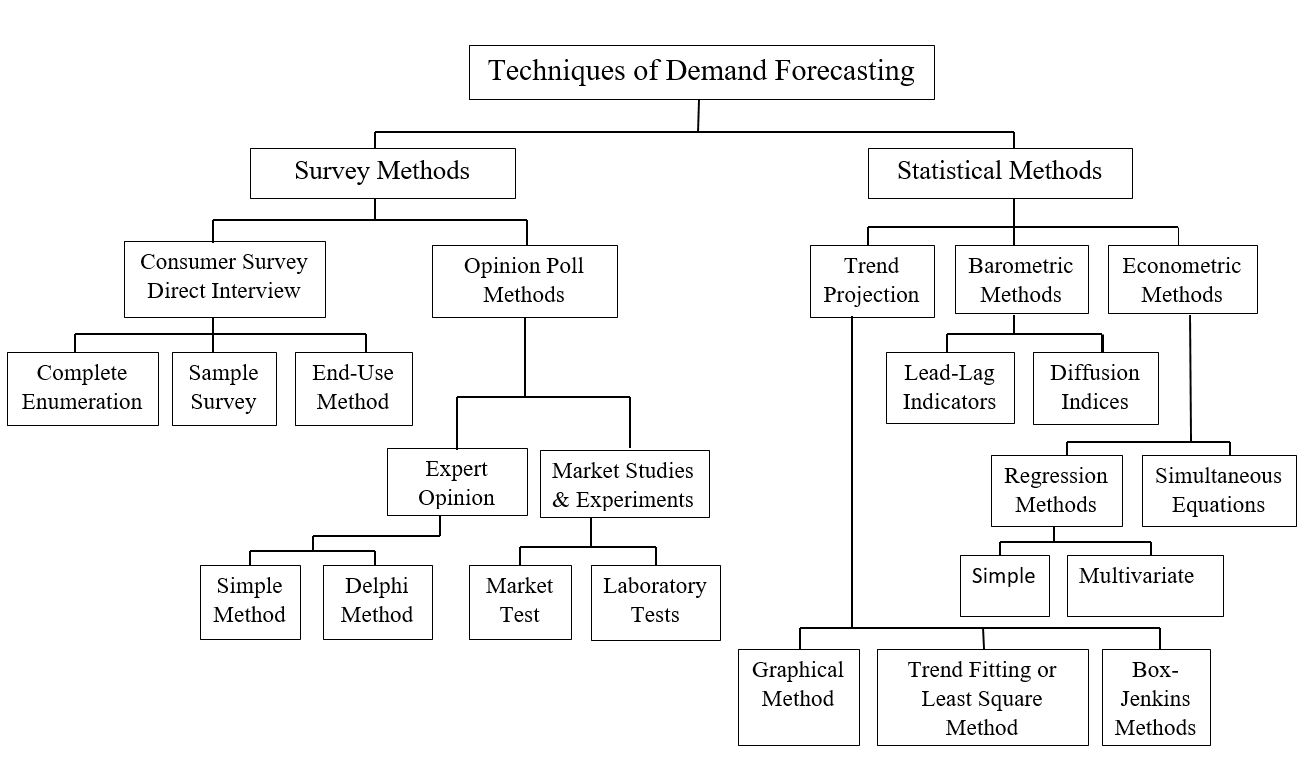Techniques and Methods of Demand Forecasting
The techniques of demand forecasting are many. These range from very naive ones that require little effort to very sophisticated ones that are very costly in terms of time and effort. Some forecasting techniques are basically qualitative, while others are quantitative. Some are based on examining only past values of the data series to forecast its future values; others involve the use of complex models based on a great deal of additional data and relationships. Some techniques, such as the barometric method, are more useful for short-term (monthly or quarterly) forecasts, while others are more useful for long-term forecasting of one year or longer. Some may be more appropriate for forecasting at the macro level, while others are better for forecasting at the micro level.
The choice of a suitable technique depends on following factors:
1. The cost of preparing the forecast and the benefit that results from its use,
2. The lead time in decision making,
3. The time period of the forecast (short term or long-term),
4. The level of accuracy required,
5. The quality and availability of the data, and
6. The level of complexity of the relationships to be forecasted.
Broadly, the forecasting techniques can be classified into following categories:
A. Survey methods
B. Statistical methods
A. Survey methods
Survey methods are generally used where the purpose is to make short-run forecast of demand. Under this method, consumer surveys are conducted to collect information about their intentions and future purchase plans. This method includes:
1. survey of potential consumer’s plan and
2. opinion poll of experts.
Let us now discuss the two methods of survey.
1. Consumer Survey Method—Direct Interviews
The most direct and simple way of assessing future demand for a product is to interview the potential consumers or users and to ask them what quantity of the product under reference they would be willing to buy at different prices over a given period, say, one year. This method is known as direct interview method. This method may cover almost all the potential consumers or only selected groups of consumers from different cities or parts of the area of consumer concentration.
Consumers can be interviewed by any of the following methods, depending on the purpose, time and cost of survey.
(a) Complete enumeration
(b) Sample survey
(c) End-use method
(a) Complete enumeration
In this method, almost all potential users of the product are contacted and are asked about their future plan of purchasing the product in question. The quantities indicated by the consumer are added together to obtain the probable demand for the product.
For example if a majority of n out of m number of households in a city individually reports the quantity (q) they are willing to purchase of a commodity, then total probable demand (Dp) may be calculated as :
where q1, q2, q3 etc. denote demand by the individual household 1, 2, 3, etc.
Limitations
1. It can be used successfully only in case of those products whose consumers are concentrated in a certain area or locality. In case of a widely dispersed market, this method may not be practically possible or may prove very costly in terms of both money and time.
2. The demand forecast through this method may not be reliable as consumers themselves may not know their actual demand in future and hence may be unable or unwilling to answer the query.
3. Even if the consumers answer, their answer to hypothetical questions may be only hypothetical and not real.
4. Consumers’ response may be biased according to their own expectations about the market conditions.
5. The plans of consumer may change with the change in the factors not included in the questionnaire.
(b) Sample Survey
In this method, only a few consumers are selected from the relevant market for the good. The consumers may be selected on a random basis or through a sampling method. These consumers are then surveyed either through direct interview or mailed questionnaires. The questions which are asked from them may relate to their income, the demand and the price of the good, whose demand is being forecasted and the price of the other competing goods. The data, which is gathered, is classified, tabulated and then analysed to determine the demand of the consumers. The information so collected is then considered to be applicable to all the consumers of the product. On the basis of the information obtained, the probable demand may be estimated through the following the following formula:
Where Dp = probable demand forecast; H = census number of households from the relevant market; Hs = number of houesholds surveyed or sample households; HR = number of households reporting demand for the product; AD = average expected consumption by the reporting households (= total quantity reported to be consumed by the reporting households ).
Advantages
1. It is simpler, less costly and less time consuming than the comprehensive survey method.
2. Has fewer data errors as compared to other survey methods.
Limitations
Same as complete enumeration method.
(c) End use method
The end-use method of demand forecasting has a considerable theoretical and practical value, especially in forecasting demand for inputs. Making forecasts by this method requires building up a schedule of probable aggregate future demand for inputs by consuming industries and various other sectors. In this method, technological, structural and other changes, which might influence the demand, are taken into account in the very process of estimation. This aspect of the end-use approach is of particulars importance.
Stages in the end-use method
The end-use method of demand forecasting consists of four distinct stages of estimation.
i. In the first stage, it is necessary to identify and list all the possible users of the product in question.
ii. The second stage of this method involves fixing suitable technical ‘norms’ of consumption of the product under study. Norms have to be established for each and every end-use. Norms arc usually expressed in physical terms either per unit of production of the complete product or in, some cases, per unit of investment or per capita use. Sometimes, the norms may have to be on value basis. But value-based norms should be avoided as far as possible because it might be rather difficult to specify later the types and sizes of the product in question if value norms are used.
iii. The third step is the application of the norms. For this purpose, it is necessary to know the desired or targeted levels of output of the individual industries for the reference year and also the likely development in other economic activities, which use the product and the likely output targets.
iv. The fourth and final stage in the end-use method is to aggregate the product wise or use-wise content of the item for which the demand is to be forecasted. This aggregate result gives the estimate of demand for the product as a whole for the year in question. By the very nature of the process of estimation described here, it is obvious that the end-use approach results in what may be termed as a “derived” demand.
Advantages
i. It is possible to work out the future demand for an industrial product in considerable details by types and size. By probing into the present use-pattern of consumption of the product, the end-use approach provides every opportunity to determine the types, categories and sizes likely to be demanded in future.
ii. In forecasting demand by the end-use approach, it is possible to trace and pinpoint at any time in future as to where and why the actual consumption has deviated from the estimated demand. Besides, suitable revisions can also be made from time to time based on such examination.




